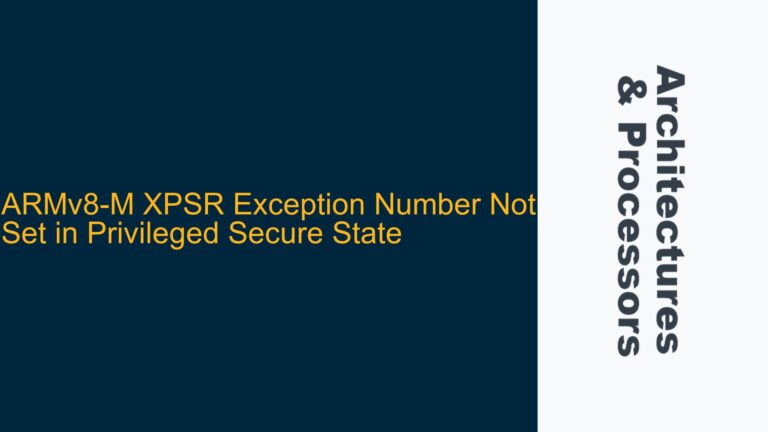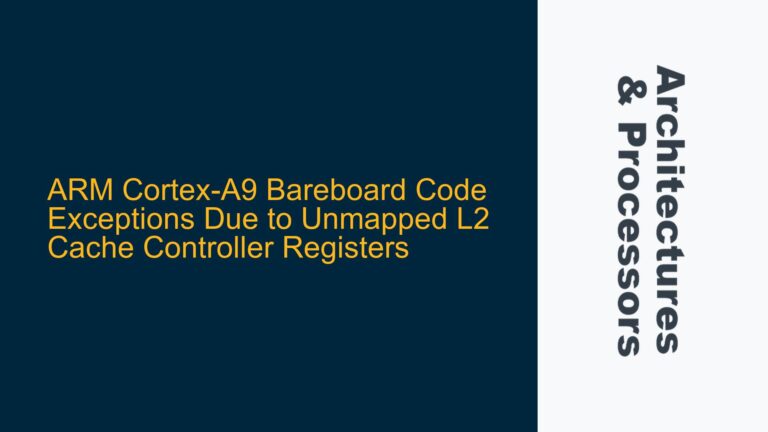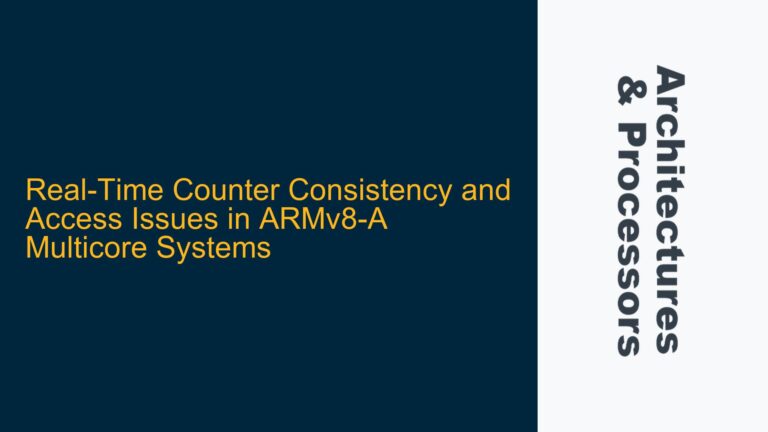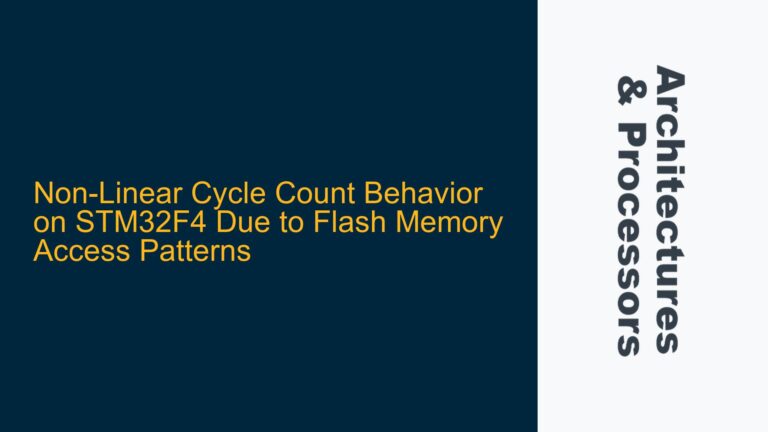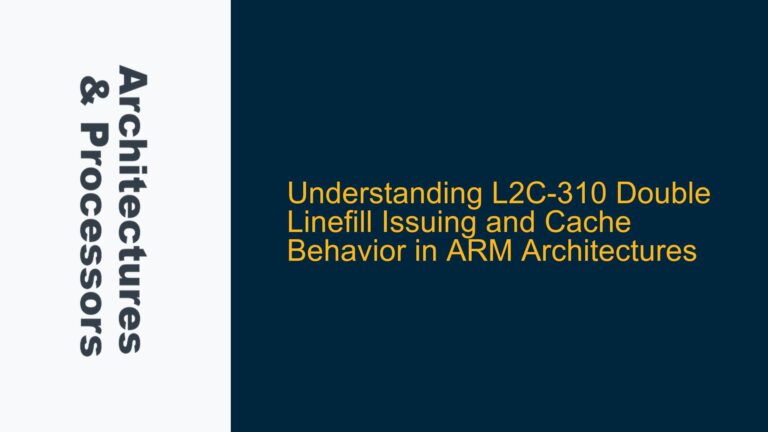ARM Cortex-M7 ITCMERR Signal Protocol and CPU Behavior
The ITCMERR signal in the ARM Cortex-M7 processor is a critical part of the Instruction Tightly Coupled Memory (ITCM) protocol, which is used to indicate errors during instruction fetches from the ITCM. When the ITCMERR signal is set HIGH, the CPU must handle the error condition in a way that ensures system stability and correct execution flow. The ITCMERR signal is typically asserted by the memory controller or the ITCM interface when an access violation, parity error, or other fault occurs during an instruction fetch.
The Cortex-M7 processor, being a high-performance embedded processor, relies on the ITCM for low-latency instruction access. The ITCMERR signal is part of the handshake protocol between the CPU and the ITCM interface. When ITCMERR is asserted, the CPU must respond appropriately to prevent incorrect instruction execution, data corruption, or system crashes. The behavior of the CPU in response to ITCMERR depends on the specific error condition and the configuration of the system.
The ITCMERR signal is typically sampled by the CPU during the instruction fetch cycle. If the signal is HIGH, the CPU must abort the current fetch operation and take corrective action. This may involve flushing the pipeline, generating an exception, or retrying the fetch operation. The exact behavior is defined by the ARM architecture and the specific implementation of the Cortex-M7 processor.
In the provided discussion, several cases are presented that illustrate different scenarios where the ITCMERR signal is asserted. These cases highlight the complexity of the ITCM protocol and the need for precise handling of error conditions. The diagrams associated with each case show the timing and sequence of events when ITCMERR is asserted, including the interaction between the CPU, the ITCM interface, and the memory controller.
Understanding the ITCMERR signal and its impact on CPU behavior is essential for debugging and optimizing systems that use the Cortex-M7 processor. Errors in the ITCM protocol can lead to subtle and difficult-to-diagnose issues, such as incorrect instruction execution, system crashes, or performance degradation. By analyzing the ITCMERR signal and its associated protocol, developers can identify and resolve these issues, ensuring reliable and efficient system operation.
Memory Access Violations and ITCMERR Signal Assertion
The ITCMERR signal is typically asserted in response to memory access violations or other errors during instruction fetches from the ITCM. These errors can occur for several reasons, including invalid memory addresses, parity errors, or timing violations. The Cortex-M7 processor is designed to handle these errors gracefully, but the exact behavior depends on the specific error condition and the system configuration.
One common cause of ITCMERR signal assertion is an invalid memory address. The ITCM is a tightly coupled memory, meaning it is directly connected to the CPU and has a fixed address range. If the CPU attempts to fetch an instruction from an address outside this range, the ITCM interface will assert the ITCMERR signal to indicate an access violation. This can happen due to software bugs, such as incorrect branch instructions or corrupted program counters.
Another cause of ITCMERR signal assertion is a parity error. The ITCM may use parity bits to detect data corruption during instruction fetches. If a parity error is detected, the ITCM interface will assert the ITCMERR signal to prevent the CPU from executing corrupted instructions. Parity errors can be caused by hardware faults, such as faulty memory cells or signal integrity issues.
Timing violations can also lead to ITCMERR signal assertion. The ITCM interface has strict timing requirements for instruction fetches. If the memory controller or the ITCM interface cannot meet these timing requirements, the ITCMERR signal may be asserted to indicate a timing violation. This can happen due to clock skew, signal delays, or other timing-related issues.
In addition to these causes, the ITCMERR signal may be asserted due to other error conditions, such as bus faults or memory controller errors. The exact cause of the ITCMERR signal assertion can be determined by analyzing the system configuration, the memory access patterns, and the error handling mechanisms in the Cortex-M7 processor.
Debugging ITCMERR Signal Issues and Implementing Corrective Measures
Debugging ITCMERR signal issues requires a systematic approach to identify the root cause of the error and implement corrective measures. The first step is to analyze the system configuration and ensure that the ITCM is properly configured and mapped to the correct address range. This includes verifying the memory map, the ITCM size, and the address decoding logic.
Next, it is important to analyze the memory access patterns and identify any potential access violations. This can be done by reviewing the software code, especially the branch instructions and the program counter values. If an access violation is detected, the software must be corrected to ensure that all instruction fetches are within the valid ITCM address range.
If the ITCMERR signal is asserted due to a parity error, the memory hardware should be inspected for faults. This includes checking the memory cells, the signal integrity, and the power supply. If a hardware fault is detected, the faulty component must be replaced or repaired.
Timing violations can be more difficult to diagnose and resolve. The first step is to analyze the clock signals and ensure that there is no clock skew or signal delay. This can be done using an oscilloscope or a logic analyzer. If a timing violation is detected, the system clock may need to be adjusted, or additional buffering may be required to meet the timing requirements.
In some cases, the ITCMERR signal may be asserted due to a bus fault or a memory controller error. These errors can be diagnosed by analyzing the bus transactions and the memory controller logs. If a bus fault is detected, the bus arbitration logic may need to be adjusted, or the memory controller firmware may need to be updated.
Once the root cause of the ITCMERR signal assertion is identified, corrective measures can be implemented. This may include software changes, hardware repairs, or system configuration adjustments. In some cases, it may be necessary to implement additional error handling mechanisms, such as exception handlers or retry logic, to ensure that the system can recover from ITCM errors gracefully.
In conclusion, the ITCMERR signal is a critical part of the ITCM protocol in the ARM Cortex-M7 processor. Understanding the causes of ITCMERR signal assertion and implementing appropriate corrective measures is essential for ensuring reliable and efficient system operation. By following a systematic approach to debugging and resolving ITCMERR signal issues, developers can ensure that their systems are robust and capable of handling error conditions effectively.

